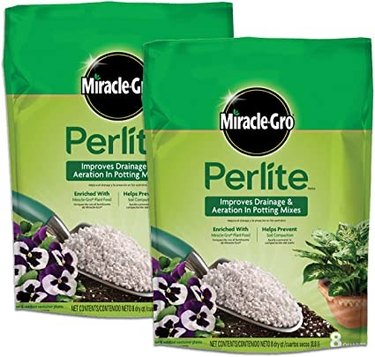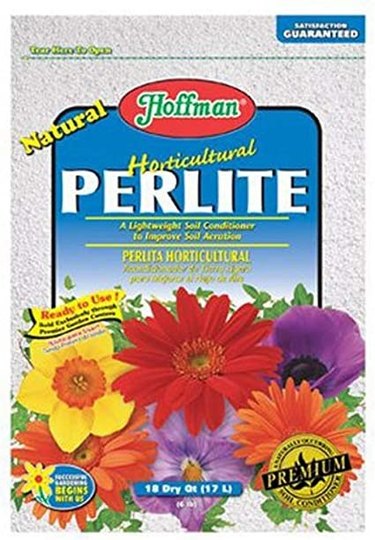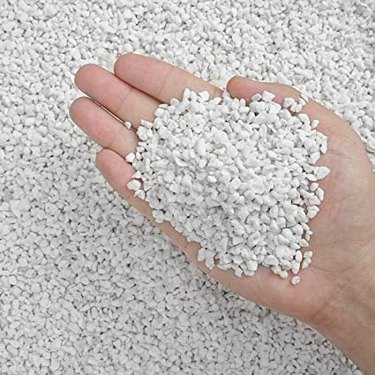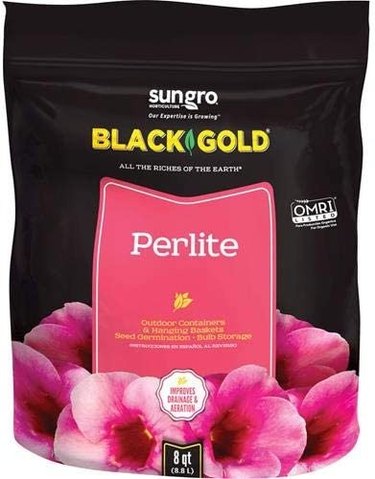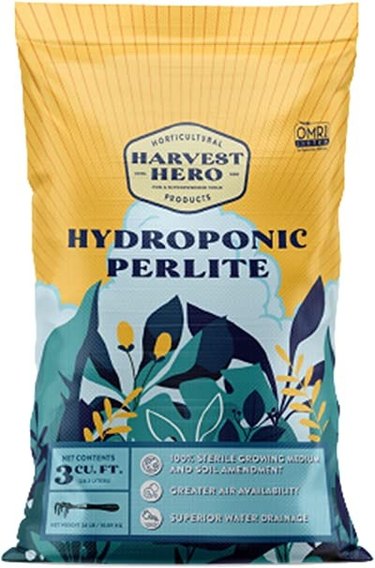
If you've purchased a potted plant, you've probably wondered what those tiny white balls that look like styrofoam spread throughout the potting soil mix are. Those tiny white balls found in growing mediums are perlite. It is a sterile, nontoxic and non-organic soil additive that improves soil structure by providing aeration and excellent drainage while reducing soil compaction.
When it comes to horticultural uses, horticultural perlite has quite a few. It can be used alone in soilless mixes for seed starting or when rooting cutting, as well as in hydroponic grow systems. You can also use it as a soil additive when making your own potting mix for use in containers, aerating heavy soils like clay, or using it to amend raised beds. Since it doesn't decompose, it's reusable and it's not expensive, as a little goes a long way.
Video of the Day
Video of the Day
Below, we've noted some considerations when choosing and using perlite and included our top picks of perlite products that fulfill various gardening needs.
What to Consider When Purchasing Perlite for Potted Plants
Perlite Pros and Cons: As with everything, perlite has its pros and cons concerning its use. However, the advantages of its use outweigh any disadvantages, which adds to its popularity with gardeners. Its sterile nature reduces the possibility of your seeds or cuttings developing root rot, damping off or other root diseases. Because it's so lightweight, you can easily pull plant roots from the perlite when it's time for transplanting or repotting without the fear of damage. It has a neutral pH, so there are no worries about the pH value of soil changing when it's mixed with other amendments.
Disadvantages include perlite's water retention properties not being as good as those of some amendments like vermiculite, so water drains away quickly. Container plants requiring more moisture planted in perlite require more frequent water applications. Its lightweight nature means it can float to the top of the soil in overly wet conditions and can easily get blown away in windy conditions. Perlite is dusty, and that dust can irritate eyes and cause respiratory problems if you breathe in too much. When working with perlite, it's best to moisten it before use or to wear a dust mask and safety goggles.
Plants Preferring Perlite: Although you can use perlite in any soil mixture for potted plants, its water-holding capacity isn't as great as other amendments like vermiculite or compost. Additionally, the size of the perlite particles also affects the soil's moisture retention. Therefore, moisture-loving potted plants require more frequent watering. However, some plants that require good drainage and soil aeration for healthy plant growth thrive in a mixture of perlite. Plants like cacti, succulents and orchids thrive growing in well-draining potting mixes amended with perlite or even straight perlite. These plants thrive in lightweight soils that are drier and retain less moisture. Soggy soils lead to disease problems like root rot and potential death.
Perlite Types: There are four grades of horticultural perlite based on the particle's size: fine, medium, coarse and super-coarse. What types you need to use is based on your growing needs. Super-coarse perlite range in size from 1/4 inch to 3/32 inches and has a water-holding capacity of only 19%. Although the large particle size leads to the best porosity for aeration and drainage, it's not that popular for horticultural uses due to the large particle size. However, you can use it as a layer of mulch on top of your potting mix.
Coarse perlite has a good balance of a water-holding capacity of 34% and drainage. Particles range between 3/16 inch and 3/64 inches, but due to their size, it doesn't blend too well in soil. However, it works well as a medium for growing orchids, cacti or succulents. Medium-grade perlite particles are between 1/8 inch and 1/32 inches and have a water-holding capacity of 46%. It's great to use as a soil amendment for potted plants or left unaltered for growing potted seedlings and seed-starting. Fine perlite's particles range between 1/16 inch to 1/128 inches, with a water-holding capacity of 52%, and work well for the propagation of seedlings and rooting cutting.
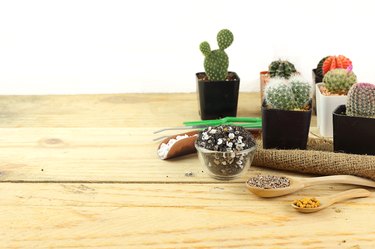
1. Miracle-Gro Perlite, 2-Pack
This medium-sized perlite from Miracle-Gro is specifically for potted plants, whether grown as houseplants or outdoors. You receive two 8-quart packages of perlite, so there's plenty for amending your potting mixes or creating your own. As a bonus, the perlite is enriched with Miracle-Gro plant food that continues feeding your plants for months. It will improve the drainage and aeration of your potting mixes, or you can use it alone for root cuttings. You can even use it to start your seedlings in hydroponic systems.
2. Hoffman Horticultural Perlite
This medium to large-sized perlite is a good choice for mixing with peat moss to make a custom soilless mix. It works great for starting seeds, cutting propagation and for storing bulbs. Due to its size, you can also use it to loosen clay soils, as it reduces caking and adds to the soil's aeration and drainage. Additionally, this perlite isn't as dusty as some types, reducing your risks of experiencing eye and respiratory irritation. It won't change the soil's pH and you get 18 quarts of the product in each bag.
3. Halatool Horticultural Organic Perlite
Halatool horticultural organic perlite comes in an 8-quart bag filled with medium-sized 3- to 6-millimeter perlite particles. It works well as a soil amendment added to increase permeability and prevent soil compaction. It has low water retention, so it is perfect for growing plants with lower water needs, such as cacti, succulents or orchids, and can be used straight for rooting cuttings. You can also incorporate it into clay soils to reduce compaction and increase porosity. This perlite is suitable for use in potted indoor plants or those grown outdoors, is sterile and won't affect the soil's pH values.
4. Gardenera Medium/Fine Grade Perlite
Gardenera's perlite with medium to fine particles is perfect for amending potting mixes for your potted plants or used to create your own soil mix. Due to the smaller particles, the perlite retains more moisture than perlite blends with larger particles, but allows for good drainage and soil aeration. Its lightweight nature reduces the risks of overwatering and decreases the chance of root rot. Root systems have an easier time spreading out for good growth. This perlite is a good choice for rooting cuttings or starting seeds and makes a good mix amendment for growing orchids, cacti, succulents or other plants with low water needs. Each bag holds 8 quarts.
5. Ace Horticultural Links Coarse Perlite
If you need coarse particles, this 8-quart bag of perlite from Ace Horticultural Links won't disappoint. This organic perlite assists in soil aeration and prevents soil compaction, although it doesn't have the water retention qualities of finer grades. This perlite works well for soilless mixes to grow succulents, orchids or cacti, as well as for seed germination and rooting cuttings. The larger particles also work well utilized like mulch on top of the soil, hydroponic grow systems, aquariums or used as a decorative feature in water features or flower beds. You can also mix one part perlite with three parts potting soil to create a lightweight and well-draining mix.
6. Sun Gro Black Gold Horticultural Perlite
Sun Gro's Black Gold perlite has fine to medium particles, making it the perfect size for amending your potting soil or used to create your own mix. It has good nutrient and moisture retention qualities and improves the soil's drainage and aeration. It makes an excellent lightweight and sterile medium for rooting cuttings or starting your seeds. You can also use it to store your bulbs over winter or make hypertufa planters. Mix the perlite with peat moss to create a potting mix. Each bag holds 8 quarts of perlite. However, due to the smaller particle size, be sure to wear face protection when using it to avoid the dust.
7. Harvest Hero Hydroponic Perlite
Harvest Hero's perlite is the perfect choice for hydroponic grow systems. For the best hydroponic performance, set the plants at a height the roots are reinforced and fill the container with the hydroponic perlite. It increases the plant's vigor by increasing oxygen uptake and creating better drainage. However, you can also use it to amend your potting mix, increasing its moisture retention and porosity, rooting cuttings, starting seeds and even use it as an amendment for raised beds. You can create an all-purpose soil mix by mixing three-parts Harvest Hero perlite with 10-parts peat moss, compost, or coco coir. Each bag contains 3 cubic feet of perlite.
